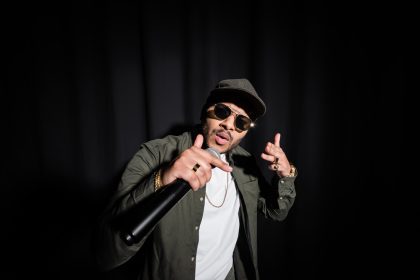The Historic Hampton House stands as a testament to Black resilience and cultural excellence. Once a safe haven during the Jim Crow era for luminaries like Muhammad Ali, Martin Luther King Jr., and Ella Fitzgerald, this Miami landmark has transformed into the world’s only Green Book museum while maintaining its position as a vital cultural institution. In an exclusive interview with Rolling Out, Chief Strategy Officer and Creative Director Curb Gardner shares how the historic venue continues to bridge past and present through art, music, and community engagement, while preserving its rich legacy in Miami’s cultural landscape.
[Editor’s note: This is a truncated transcription of a longer video interview. Please see the video for the extended version. Some errors may occur.]
What is your role at the Historic Hampton House?
I am Chief Strategy Officer and Creative Director. I’m responsible for the trajectory of the museum regarding its programming, regarding how it’s viewed in the world, regarding the impact it will make as the only Green Book Museum in the world.
Can you share the history of the Historic Hampton House and its significance to the community?
Back in the Jim Crow era, which is the 1950s, 60s—prior to Black people, and you may know from your grandmother’s stories or your grandfather’s stories—that when they traveled from North to South or within the South, it was not a safe place to travel. You couldn’t go to a gas station, you couldn’t go to a restaurant—that’s why we had to sit in counters. You couldn’t go to a hotel.
So, there’s a gentleman by the name of Victor Green who created this book, like a little phone book. And it was a guide that told you where, in whatever city—in Knoxville, in Atlanta, in Tallahassee, in Detroit—where you could stay and be accepted as a person of color.
The Historic Hampton House was built in 1954. Harry Belafonte performed that night at the opening night with a white audience, standing ovation, but he couldn’t stay there. So, he stayed over at the Historic Hampton House. He stayed over town in this area called Brownsville, which was the most elegant place, most luxurious place that he could stay. Ella Fitzgerald, Duke Ellington, Sam Cooke—everybody who was anybody stayed at that hotel. Martin Luther King, just everyone, Malcolm X, Muhammad Ali—everyone.
How does the Hampton House serve the community today?
It is actually, it’s now a museum. I actually found the space as I was producing the premiere of Regina King’s film, “One Night in Miami.” I get there, and I’m like, “Oh my God, I’ve been in Miami since 2014. Why don’t I know about this place?” We’ve shifted the narrative where it’s become, once again, we’re housing artists, both performers—we’ve recently had Chaka Khan, Eric Benet, and these private concerts—and visual artists, which is why we’re part of Art Basel.
We have a new partnership with Montreux Jazz Festival, which is the oldest jazz festival in the world, to bring live music back. We’re so blessed to be able to tie into Art Basel VIP. We’re the only institution of its sort that’s VIP that’s officially with them.
Tell us about the Invisible Luggage exhibit that debuted during Art Basel.
This is our second year with Art Basel, an exhibition during Art Basel. Our first year was said to be one of the best, and we’re so blessed that this year too has been lauded as one of the best exhibitions during Art Basel. Invisible Luggage is something that I think we should all—that we all carry, right? I think that at this moment in time in American history, we need to look at ourselves and understand who we are.
Take a moment, go inside yourself and do some self-assessment, and then what is it that you’re carrying? Is it trauma? And what kind of joy are you carrying? The show is really about how we travel through life and what we carry with us and what we need to sometimes unpack.
Rolling Out and Mielle were very intentional about working with the Historic Hampton House for our partnership, The Art of Hair. Our brands’ legacy and heritage seemed to align perfectly with your space.
We are very particular and very intentional about the partnerships that we have because we are a museum—we’re a new museum. And in order to be able to attract brands on a national level, they are looking for a certain expertise and a certain quality and a certain commitment to excellence. You’ve got Munson Steed, you’ve got Monique Rodriguez, and those two are legends in their own right.
So here you are—you have them come into a place and be accepted and get on the wall with Malcolm X, Muhammad Ali, Josephine Baker. They’re black women there. They use those hair care products. I mean, we need our hair care product. I appreciate this responsibility of Mielle educating its audience to our history.
The event had several components, including a networking reception in the courtyard and a private VIP dinner.
It was a VIP dinner of influencers and activists and business leaders who basically had a wonderful master table, and it was a master class. And how people are presenting themselves in business. How they’re presenting their art, and their art form. And I think it was just magical. We had everything from caviar to lobster, and it was a beautiful setting. And I think people really felt good, and we wanted people to feel good about their accomplishments.
The conversation at the table really spoke to the why—why we chose the Historic Hampton House, why Mielle chose to be here for their 10th anniversary.
And 50 of the most important young artists in the world that are there today. I mean, these artists are well revered, and they’ve been collected not only in museums, but they are some are young and budding, but their careers are very, very vivacious. And so, for us to know who our artists are. And so, to be in the space where you can now rooted in history. But now we’re taking the floor with modern day artists.
We also offered private tours of the exhibit and spaces within the Historic Hampton House to the community.
And for Mielle and Rolling Out provide that opportunity for community to see. And then a reception that they dance with DJ MOS, specialty cocktails and the food was outstanding. I think that brands have an opportunity to either bring community along with them or have them just be using their product, but then they can educate them in many ways. Not only about their product, but also give them such pride in themselves and pride in your own history.
The visual lift and learn experience was unique, along with gift bags containing products, signed prints, and custom t-shirts.
You guys are at the forefront. The fact of matter is that we are a wonderful little secret. There are so many articles written about the Historic Hampton House about the exhibition from Forbes magazine, mainstream magazines. But you guys are like at the top of it. You’re understanding and getting things out where we need that partnership. We need that partnership so we can learn about our own history through our own community.
What’s next for the Historic Hampton House?
We’ve got coming up is that we’re now connected, we’re going to be doing something for Food and Wine. We have an international partnership with Montreux Jazz. You’re going to see some big celebrities come through the Historic Hampton House. We have this music series called From Be Bop to Hip Hop, which is a supper club.
We do two sets, and then we stream it live as well so people that can’t get the ticket can go virtual for that. When you come to the Hampton House you get a virtual key that key works in every door in every room, which means that this history is yours. It never expires, and the light never turns out. So come on back home and use your room.














